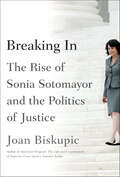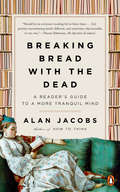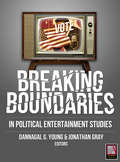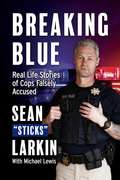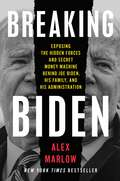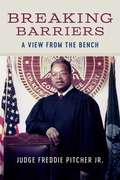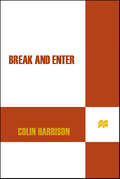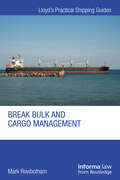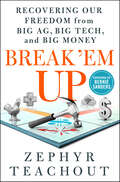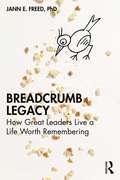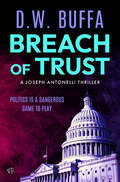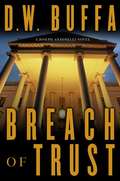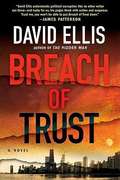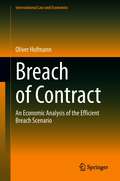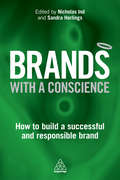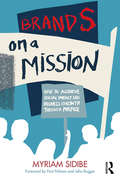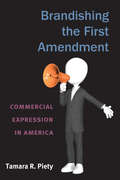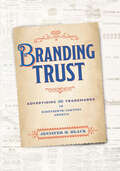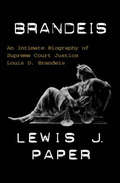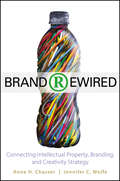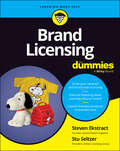- Table View
- List View
Breaking In: The Rise of Sonia Sotomayor and the Politics of Justice
by Joan Biskupic"I knew she'd be trouble."So quipped Antonin Scalia about Sonia Sotomayor at the Supreme Court's annual end-of-term party in 2010. It's usually the sort of event one would expect from such a grand institution, with gentle parodies of the justices performed by their law clerks, but this year Sotomayor decided to shake it up—flooding the room with salsa music and coaxing her fellow justices to dance. It was little surprise in 2009 that President Barack Obama nominated a Hispanic judge to replace the retiring justice David Souter. The fact that there had never been a nominee to the nation's highest court from the nation's fastest growing minority had long been apparent. So the time was ripe—but how did it come to be Sonia Sotomayor? In Breaking In: The Rise of Sonia Sotomayor and the Politics of Justice, the veteran journalist Joan Biskupic answers that question. This is the story of how two forces providentially merged—the large ambitions of a talented Puerto Rican girl raised in the projects in the Bronx and the increasing political presence of Hispanics, from California to Texas, from Florida to the Northeast—resulting in a historical appointment. And this is not just a tale about breaking barriers as a Puerto Rican. It's about breaking barriers as a justice. Biskupic, the author of highly praised judicial biographies of Justice Antonin Scalia and Justice Sandra Day O'Connor, now pulls back the curtain on the Supreme Court nomination process, revealing the networks Sotomayor built and the skills she cultivated to go where no Hispanic has gone before. We see other potential candidates edged out along the way. And we see how, in challenging tradition and expanding our idea of a justice (as well as expanding her public persona), Sotomayor has created tension within and without the court's marble halls. As a Supreme Court justice, Sotomayor has shared her personal story to an unprecedented degree. And that story—of a Latina who emerged from tough times in the projects not only to prevail but also to rise to the top—has even become fabric for some of her most passionate comments on matters before the Court. But there is yet more to know about the rise of Sonia Sotomayor. Breaking In offers the larger, untold story of the woman who has been called "the people's justice."
Breaking Bread with the Dead: A Reader's Guide to a More Tranquil Mind
by Alan JacobsFrom the author of HOW TO THINK and THE PLEASURES OF READING IN AN AGE OF DISTRACTION, a literary guide to engaging with the voices of the past to stay sane in the presentW. H. Auden once wrote that "art is our chief means of breaking bread with the dead." In his brilliant and compulsively readable new treatise, Breaking Bread with the Dead, Alan Jacobs shows us that engaging with the strange and wonderful writings of the past might help us live less anxiously in the present--and increase what Thomas Pynchon once called our "personal density."Today we are battling too much information in a society changing at lightning speed, with algorithms aimed at shaping our every thought--plus a sense that history offers no resources, only impediments to overcome or ignore. The modern solution to our problems is to surround ourselves only with what we know and what brings us instant comfort. Jacobs's answer is the opposite: to be in conversation with, and challenged by, those from the past who can tell us what we never thought we needed to know.What can Homer teach us about force? How does Frederick Douglass deal with the massive blind spots of America's Founding Fathers? And what can we learn from modern authors who engage passionately and profoundly with the past? How can Ursula K. Le Guin show us truths about Virgil's female characters that Virgil himself could never have seen? In Breaking Bread with the Dead, a gifted scholar draws us into close and sympathetic engagement with texts from across the ages, including the work of Anita Desai, Henrik Ibsen, Jean Rhys, Simone Weil, Edith Wharton, Amitav Ghosh, Claude Lévi-Strauss, Italo Calvino, and many more.By hearing the voices of the past, we can expand our consciousness, our sympathies, and our wisdom far beyond what our present moment can offer.
Breaking Boundaries: In Political Entertainment Studies
by Michael X. Delli Carpini Jonathan Gray Larry Gross Jeffrey P. Jones Roderick P. Hart Dannagal G. Young Lauren Feldman Megan R. Hill Geoffrey Baym Heather Lamarre Amber Day R. Lance Holbert Paul R. Brewer Arlene Luck Lindsay HoffmanThis book brings together a collection of scholars whose work is leading the field of political entertainment studies, and yet it crosses methodological divides to do so, with quantitative and critical/cultural perspectives both represented. Indeed, each author worked as a part of a pair, addressing a similar topic as a colleague from across the divide. The result is a series of essays that add to and move beyond the state of political entertainment research--not only in content, but also in approach--by challenging readers to expand their thinking on these topics outside of the regular strictures. It begins with direct discussion of methodological divides in the field, as Michael Delli Carpini and Jeffrey P. Jones offer an essay, response, and further response. Following this initial, explicit tackling of methodology and what is at stake, Geoffrey Baym and Lindsay Hoffman each examine partisan language and interviews in The Daily Show with Jon Stewart and The Colbert Report, respectively; Lauren Feldman and Paul Brewer examine satirical treatments of science; Amber Day and Heather LaMarre address the importance of Stephen Colbert's Super PAC; Dannagal G. Young and Roderick Hart discuss The Daily Show's treatment of political participation, citizenship, and social protest; and finally, Megan Hill and R. Lance Holbert each wrestle with developing a normative approach to political satire. Read what scholars think!
Breaking Blue: Real Life Stories of Cops Falsely Accused
by Sean "Sticks" LarkinBody cams and dashcams have fundamentally transformed law enforcement in recent years. These innovations can help prove someone committed a crime, or didn't. Real-life footage has cleared people initially accused of wrongdoing, and in certain instances even implicated officers. But that same type of footage can also be used to clear police falsely accused of misdeeds. From allegations of harassment or bias to false arrests or even criminal conduct, these videos can prove officers did not cross a line as sometimes they are alleged to have done. Breaking Blue is the first book that shares real stories of cops accused of wrongdoing and subsequently cleared. Charges may have been brought against them, Internal Affairs may have started an investigation, but in many cases, thanks to the officer&’s body cam or dashcam videos, the true story came to light, with charges ultimately dismissed or initial convictions overturned. Sergeant Sean &“Sticks&” Larkin of the Tulsa Police Department Gang Unit and host of A&E show Live PD, presents real stories of officers falsely accused. . .. including his own. Now, we can finally get both sides of the story for citizens and the police officers hired to serve and protect.
Breaking Biden: Exposing the Hidden Forces and Secret Money Machine Behind Joe Biden, His Family, and His Administration
by Alex MarlowINSTANT NEW YORK TIMES BESTSELLER The New York Times bestselling author of the &“must-read&” (Sean Hannity) Breaking the News and editor-in-chief of Breitbart News Network returns with this timely and eye-opening deep dive investigation into the 46th president.Over his 50-year career in Washington, Joe Biden has become known for his wild dishonesty, embarrassing policy failings, and an absolute lack of accountability, culminating in his predictably unpopular presidency. But what has not yet been revealed is the vast web of consultants, bureaucrats, corporate titans, foreign interests, and various extended family members (it&’s not just Hunter!) who have achieved unfathomable wealth and power while keeping Biden in charge. Now, Alex Marlow reports the findings of a shocking, in-depth investigation into the individuals and entities behind the devastating decisions that have empowered the global elite at the expense of the American public. With his signature &“prescient&” (Tucker Carlson) writing, Marlow unearths new details such as: EXPOSED: The secret cadre of consultants running Joe Biden&’s Washington. EXPLAINED: How Joe Biden sold America&’s intellectual property to communist China. UNCOVERED: The unreported and audacious reason the underwhelming, under-qualified, and unpopular Kamala Harris was chosen to be vice president. REVEALED: All the ways the Bidens&’ bag cash off of the family name.
Breaking Barriers: A View from the Bench
by Freddie Pitcher Jr.In Breaking Barriers, Judge Freddie Pitcher Jr. describes how he made history in Baton Rouge by becoming the first African American to be elected to judgeships at three different levels of the court system. Pitcher recounts his early years in Valley Park—a segregated and semi-rural neighborhood—where one of his cousins, a civil rights attorney, served as his role model and inspired him to become both a lawyer and an agent of change. Pitcher depicts what it was like to grow up in the segregated South and how racial discrimination fueled his drive to challenge the norms of the Baton Rouge judiciary later in life. Pitcher discusses how he forged together Black political organizations, the Black church community, and a group of white attorneys into a campaign coalition that ultimately helped him overcome the racial barriers that prevented Black people from ascending to the judiciary in Baton Rouge. He details the strategy used to win seats on both the Baton Rouge City Court and the 19th Judicial District Court at a time when many said a Black candidate could not win a city- or parish-wide election. He describes many of the challenges he faced as the first and only Black judge in Baton Rouge while highlighting some of the notable cases he tried and sharing his beliefs about judging and the judicial process. Pitcher’s story of rising from “the bench to the bar to the bench”—from the bench outside the local grocery store that he and his friends frequented as young boys, to the Louisiana bar, to the judicial bench—is informative and inspiring, shedding light on the perseverance and determination required of early African American candidates to overcome the many roadblocks to full participation in the political process related to the judiciary.
Break and Enter: A Novel
by Colin HarrisonPeter Scattergood is a Philadelphia Assistant District Attorney, a relentless and clever prosecutor who has just landed the biggest case of his career--a double homicide, involving the mayor's nephew and his mistress. This is not the best time for his wife to walk out on their crumbling marriage and to disappear. As Peter tries to find his wife, and to build his case, he is drawn into an affair with an alluring stranger named Cassandra, a woman whose greatest skill is arousing suspicion. Break and Enter is an intense, intricate thriller about the thresholds we must cross in order to get at the truth.
Break Point: Two Minnesota Athletes and the Road to Title IX
by Sheri BrendenHow two teenage girls in Minnesota jump-started a revolution in high school athletics Peggy Brenden, a senior, played tennis. Toni St. Pierre, a junior, was a cross country runner and skier. All these two talented teenagers wanted was a chance to compete on their high school sports teams. But in Minnesota in 1972 the only way on the field with the boys ran through a federal court—so that was where the girls went. Break Point tells the story, for the first time, of how two teenagers took on the unequal system of high school athletics, setting a legal precedent for schools nationwide before the passage of Title IX.As Peggy&’s younger sister, author Sheri Brenden is uniquely positioned to convey the human drama of the case, the stakes, and the consequences for two young women facing the legal machinery of the state, in court and in school. In an account that begins with Peggy painstakingly typing her appeal to the Minnesota Civil Liberties Union and concludes with a long view of what Brenden v. Independent School District 742 set in motion, Sheri Brenden summons the salient details of this landmark case as it makes its way through the courts. Peggy and Toni, coaches, administrators, and experts testify before Judge Miles Lord, whose decision, upheld in a precedent-setting appeal, would change these girls&’ lives and open up athletic opportunities for innumerable others.Grounded in newspaper coverage, court records, and interviews, Brenden&’s deeply researched, scrupulously reported book is at heart the story of two talented teenage girls whose pluck and determination—and, often, heartache—led to a victory much greater than any high school championship.
Break Bulk and Cargo Management (Lloyd's Practical Shipping Guides)
by Mark RowbothamThis book covers the subjects of break bulk cargo, general cargo and project cargo, and how these cargoes are shipped. It deals with the cargoes themselves, the vessels used for their carriage, and how the carriage is managed using the process of vessel chartering. Alongside these, it also covers offshore vessel management and how offshore supply vessels are used to carry cargoes to offshore oil and gas installations. Break bulk cargo covers a wide variety of cargoes, from project cargo to more varied cargoes carried on an ad hoc basis, often between ports that are not equipped for container traffic. It also covers the carriage of specific cargoes that cannot fit inside or are unsuitable for containers. This includes the carriage of cargoes for major projects, and cargoes for the offshore sector, which is an area covered in a specific section in the book concerning the use of offshore supply vessels. To date, only minor elements of shipping books cover this kind of trade, hence the need for a new book that specifically covers this subject. The focus of this book is providing expert insights and detailed explanations of the practical issues related to all aspects of break bulk and general cargo management. The book is written for legal practitioners, shipping managers, managers of project cargo, oil and gas companies, shipping professionals, charterers, shipbrokers, shippers and anybody else involved in ad hoc vessel chartering for the carriage of break bulk, general and project cargoes. It will also serve as a valuable resource for students of shipping.
Break 'Em Up: Recovering Our Freedom from Big Ag, Big Tech, and Big Money
by Zephyr Teachout"[We need] a grassroots, bottom-up movement that understands the challenge in front of us, and then organizes against monopoly power in communities across this country. This book is a blueprint for that organizing. In these pages, you will learn how monopolies and oligopolies have taken over almost every aspect of American life, and you will also learn about what can be done to stop that trend before it is too late." —From the foreword by Bernie Sanders.A passionate attack on the monopolies that are throttling American democracy.Every facet of American life is being overtaken by big platform monopolists like Facebook, Google, and Bayer (which has merged with the former agricultural giant Monsanto), resulting in a greater concentration of wealth and power than we've seen since the Gilded Age. They are evolving into political entities that often have more influence than the actual government, bending state and federal legislatures to their will and even creating arbitration courts that circumvent the US justice system. How can we recover our freedom from these giants? Anti-corruption scholar and activist Zephyr Teachout has the answer: Break 'Em Up.This book is a clarion call for liberals and leftists looking to find a common cause. Teachout makes a compelling case that monopolies are the root cause of many of the issues that today's progressives care about; they drive economic inequality, harm the planet, limit the political power of average citizens, and historically-disenfranchised groups bear the brunt of their shameful and irresponsible business practices. In order to build a better future, we must eradicate monopolies from the private sector and create new safeguards that prevent new ones from seizing power.Through her expert analysis of monopolies in several sectors and their impact on courts, journalism, inequality, and politics, Teachout offers a concrete path toward thwarting these enemies of working Americans and reclaiming our democracy before it’s too late.
Breadcrumb Legacy: How Great Leaders Live a Life Worth Remembering
by Jann E. FreedLegacy can seem far off and out of reach, but it doesn’t happen at journey’s end and it’s not only for the rich and famous. Legacy is now, and this book shows leaders how you can find and leave meaning on a daily basis. Jann E. Freed, PhD, introduces her Breadcrumb Legacy™ framework, a radical but pragmatic approach, made up of small actions you consciously take over time that accumulate into the trail, or legacy, you’ll leave behind. Breadcrumb Legacy is also a mindset, an awareness of the impact you’re having on your relationships, your organization, and your family, in every communication and interaction. This book is the guide to leaving a trail of meaning throughout your life and career. Based on in-depth interviews, Breadcrumb Legacy provides inspiration and practical stories for living a life worth remembering.
Breach of Trust (The Joseph Antonelli Thrillers)
by D. W. BuffaEdgar Award–Nominated Series: A courtroom case has dangerous implications for a presidential race—and a group of friends who thought they&’d left the past behind . . .&“Electrically charged.&” —The New York Times on The Prosecution When defense attorney Joseph Antonelli attends a Harvard Law School reunion at Manhattan&’s Plaza Hotel, he isn&’t prepared for how unsettling his return will be. Long ago, at a party in this very hotel, a young woman fell from a window to her death. At the time, the event was ruled an accident, but the case is about to be reopened, and a possible witness, the vice president of the United States, is wary of its potential to ruin his political chances . . . When the trial begins, the nation&’s eyes turn to the accused, and to the powerful players both within and beyond the White House who want the downtrodden suspect out of the way. But can Antonelli uncover just where the secrets lie—and exactly who is playing whom? &“Maddening suspense, captivating courtroom scenes, and a marvelously twisted ending.&” —Booklist Praise for the Joseph Antonelli Thrillers &“Adroit and often elegant.&” —Los Angeles Times &“Absorbing.&” —Orlando Sentinel
Breach of Trust (Joseph Antonelli #6)
by D. W. BuffaDefense attorney Joseph Antonelli dives into a case of White House intrigue, intimacies not forgotten, and suspicions dark and deep in this legal thriller in the critically acclaimed, Edgar Award-nominated series. In Breach of Trust, Antonelli is seduced into taking an old case that has dangerous implications not just for the upcoming United States presidential race but also for a group of old friends who thought they had put far behind them the sudden death of a young woman years ago. When Antonelli attends a Harvard Law School reunion in Manhattan, at the very same hotel where the lively young woman fell from a window to her death, he doesn't suspect how disturbing his return will be. The case was never solved at the time and has now been reopened, and a potential witness--a man with promise and ambition in equal measure--is wary that the story may ruin his political chances to run for vice president of the United States. When the trial begins, the nation's eyes turn to the accused--a downtrodden lawyer who was once a member of this elite circle of friends--and also to the unseen powers both within and without the White House that want to bury him. It is up to the shrewd and sharp Antonelli to uncover just where the secrets lie--and exactly who is playing whom. Breach of Trust is a scintillating drama from a master of elegant suspense.
Breach of Trust (A Jason Kolarich Novel #2)
by David EllisOn the night his wife and infant daughter died, attorney Jason Kolarich was awaiting a call from an informant. He blames himself not only for the deaths of his family, but for the informant's murder as well. Kolarich can't bring back his family, but he can find the person who killed the informant. And he discovers that his informant's murder was only the tip of the iceberg-and that exposing the truth will drag him into the fight of his life.
Breach of Contract: An Economic Analysis of the Efficient Breach Scenario (International Law and Economics)
by Oliver Hofmann“Efficient breach” is one of the most discussed topics in the literature of law and economics. What remedy incentivizes the parties of a contract to perform contracts if and only if it is efficient? This book provides a new perception based on an in-depth analysis of the impact the market structure, asymmetry of information, and deviations from the rational choice model have, comprehensively. The author compares the two predominant remedies for breach of contract which have been adopted by most jurisdictions and also found access to international conventions like the Convention on Contracts for the International Sale of Goods (CiSG): Specific performance and expectation damages. The book illustrates the complexity such a comparison has under more realistic assumptions. The author shows that no simple answer is possible, but one needs to account for the circumstances. The comparison takes an economic approach to law applying game theory. The game-theoretic models are consistent throughout the entire book which makes it easy for the reader to understand what effects different assumptions about the market structure, the distribution of information, and deviations from the rational choice model have, and how they are intertwined.
Brazilian Environmental and Climate Change Law
by Rafael Martins Costa Moreira Gabriel WedyThe book covers a range of topics including the historical evolution and present landscape of Brazilian environmental law; fundamental principles of environmental law; environmental constitutionalism in Brazil; the legal framework governing environmental assets; animal protection and rights; environmental federalism; national environmental policy; administrative tools for environmental regulation; civil and criminal environmental liability; judicial interpretations of environmental law; specially protected areas; climate change legislation and litigation; and water resource management. This book is intended for those interested in Brazilian environmental and climate change law, specifically catering to students, lawyers, jurists, scholars, and anyone eager to grasp the key aspects and current status of this field. With the international focus on Brazil as a 'continental Country' and the limited availability of English literature on the subject, compounded by the challenges many non-Portuguese speaking academics encounter, this book serves as a comprehensive resource for understanding how Brazil's legal and justice systems address environmental issues.
Brandschutztechnische Anforderungen an Bauteile: Mit Tabellen nach DIN 4102 und DIN EN 13501
by Anna Maria von HippelDas Bauordnungsrecht ist Landesrecht. 16 Landesbauordnungen sind in Deutschland nötig, um die brandschutztechnischen Anforderungen an Bauteile in dem Bundesgebiet zu regeln.Dieses Nachschlagewerk gibt eine Übersicht über die geltenden bauaufsichtlichen Anforderungen an Bauteile und verweist auf die gesetzlichen Fundstellen. Die bauaufsichtlichen Anforderungen werden in Tabellen zusammengestellt und nach DIN 4102 und DIN EN 13501 angegeben. Das Fachbuch gliedert sich in 3 Abschnitte. Im ersten Abschnitt werden Grundlagen dargestellt und Aufbau und Handhabung des Werks erläutert. Im zweiten Abschnitt wir ein bauteilbezogener und im dritten Abschnitt ein bundeslandbezogener Vergleich der bauaufsichtlichen Anforderungen an Bauteile dargestellt. Die Tabellensammlung im dritten Abschnitt schließt mit einer Synopse der gesetzlichen Fundstellen in den 16 Landesbauordnungen und der Musterbauordnung (MBO) ab.
Brands, Competition Law and IP
by Ioannis Lianos Spencer Weber Waller Desai, Deven R. and Lianos, Ioannis and Waller, Spencer Weber Deven R. DesaiBrands and brand management have become a central feature of the modern economy and a staple of business theory and business practice. Contrary to the law's conception of trademarks, brands are used to indicate far more than source and/or quality. This volume begins the process of broadening the legal understanding of brands by explaining what brands are and how they function, how trademark and antitrust/competition law have misunderstood brands, and the implications of continuing to ignore the role brands play in business competition. This is the first book to engage with the topic from an interdisciplinary perspective, hence it will be a must-have for all those interested in the phenomenon of brands and how their function is recognized by the legal system. The book integrates both a competition and an intellectual property law dimension and explores the regulatory environment and case law in both Europe and the United States.
Brands with a Conscience
by Nicholas Ind Sandra HorlingsThe definitive expert guide to ethical brand practice from the prestigious Medinge Group, Brands with a Conscience dissects the philosophies underpinning sustainable brands to arrive at a set of eight clear guiding attributes which can be used as the foundation of a strategy for responsible growth. These attributes span the public persona of an organization, the actions to take when things go wrong, the effort invested in developing relationships, the promotion of core values and balancing measures of success across economic, human, social and environmental factors. They are then used as the criteria to assess twelve carefully selected case studies, which include Dilmah Tea, H&M, Dr. Hauschka, Merci and the John Lewis Partnership, amongst other leading international brands. Because the potential to have bad practice unmasked or to have successes amplified online is greater than ever, it pays to adopt a strategy that builds customer loyalty and trust. Brands with a Conscience inspires via examples of brands which not only exhibit a genuine desire to operate ethically, but also have seen impressive success in terms of engagement with consumers, reputation, and return on investment. The book includes a range of practical tools to bring together the main concepts in an easy-to-adopt framework for building a brand strategy based upon real world experience. If you are a brand manager or marketing professional seeking a conscientious approach to consumer engagement, then Brands with a Conscience will support you every step of the way.
Brands on a Mission: How to Achieve Social Impact and Business Growth Through Purpose
by Myriam SidibeBrands on a Mission explores the importance of creating a performance culture that is built on driving impact through purpose, and the type of talent required to drive these transformational changes within companies – from CEO to brand developers. Using evidence from interviews and stories from over 100 CEOs, thought leaders and brand managers, the book presents an emergent model that organisations can follow to build purpose into their growth strategy – and shows how to bridge the gap between Brand Say and Brand Do. Readers will learn from the real experts in the field: how Paul Polman, former CEO of Unilever, built purpose into the DNA of his company; what keeps Alan Jope (new CEO, Unilever) and Emmanuel Faber (CEO, Danone) awake at night; and how brand developers from Durex, Dove, Discovery and LIXIL have made choices and the reasons behind them. In this book you will learn how a soap brand Lifebuoy taught one billion people about hygiene, how a beer is tackling gender-based violence, and how a toothpaste is tackling school absenteeism amongst many others. Renowned experts like Peter Piot (Director, London School of Health and Tropical Medicine), Michael Porter (Professor, Harvard School of Business), Jane Nelson (Director, Corporate Responsibility Initiative, Harvard Kennedy School) and Susie Orbach (leading feminist and formerly professor, London School of Economics) also share examples, data and their everyday experiences of helping corporates create a culture of purpose. And leading NGOs and UN experts like Lawrence Haddad (Executive Director, GAIN) and Natalia Kanem (Executive Director of UNFPA) will recount how the public and private sector have worked together to create an accelerated path to reaching the Sustainable Development Goals by 2030. The book provides a clear pathway of how to take brands through the journey of developing impactful social missions and driving business growth, and is an essential guide for both managers and students alike.
Brandishing the First Amendment: Commercial Expression in America
by Tamara R. PietyOver the past two decades, corporations and other commercial entities have used strategic litigation to win more expansive First Amendment protections for commercial speech-from the regulation of advertising to the role corporate interests play in the political process, most recently debated in the Supreme Court case ofCitizens United v. Federal Election Commission. Tamara R. Piety, a nationally known critic of commercial and corporate speech, argues that such an expansion of First Amendment speech rights imperils public health, safety, and welfare; the reliability of commercial and consumer information; the stability of financial markets; and the global environment. Beginning with an evaluation of commonly evoked philosophical justifications for freedom of expression, Piety determines that, while these are appropriate for the protection ofan individual's rights,they should not be applied too literally tocommercialexpression because the corporate person is not the moral equivalent of the human person. She then gathers evidence from public relations and marketing, behavioral economics, psychology, and cognitive studies to show how overly permissive extensions of First Amendment protections to commercial expression limit governmental power to address some of the major social, economic, and environmental challenges of our time. "The timeliness of the topic and the provision of original positions are sure to make the book a valuable contribution that should draw much attention. " -Kevin W. Saunders, Michigan State University
Branding Trust: Advertising and Trademarks in Nineteenth-Century America (American Business, Politics, and Society)
by Jennifer M. BlackIn the early nineteenth century, the American commercial marketplace was a chaotic, unregulated environment in which knock-offs and outright frauds thrived. Appearances could be deceiving, and entrepreneurs often relied on their personal reputations to close deals and make sales. Rapid industrialization and expanding trade routes opened new markets with enormous potential, but how could distant merchants convince potential customers, whom they had never met, that they could be trusted? Through wide-ranging visual and textual evidence, including a robust selection of early advertisements, Branding Trust tells the story of how advertising evolved to meet these challenges, tracing the themes of character and class as they intertwined with and influenced graphic design, trademark law, and ideas about ethical business practice in the United States.As early as the 1830s, printers, advertising agents, and manufacturers collaborated to devise new ways to advertise goods. They used eye-catching designs and fonts to grab viewers’ attention and wove together meaningful images and prose to gain the public’s trust. At the same time, manufacturers took legal steps to safeguard their intellectual property, formulating new ways to protect their brands by taking legal action against counterfeits and frauds. By the end of the nineteenth century, these advertising and legal strategies came together to form the primary components of modern branding: demonstrating character, protecting goodwill, entertaining viewers to build rapport, and deploying the latest graphic innovations in print. Trademarks became the symbols that embodied these ideas—in print, in the law, and to the public.Branding Trust thus identifies and explains the visual rhetoric of trust and legitimacy that has come to reign over American capitalism. Though the 1920s has often been held up as the birth of modern advertising, Jennifer M. Black argues that advertising professionals had in fact learned how to navigate public relations over the previous century by adapting the language, imagery, and ideas of the American middle class.
Brandeis: An Intimate Biography of Supreme Court Justice Louis D. Brandeis
by Lewis J. PaperThis vivid biography reflects the fullness of Supreme Court Justice Louis D. Brandeis' personal and professional lives. Born in Kentucky shortly before the Civil War, Brandeis rose to national fame as "the people's attorney"--the first public interest lawyer--and went on to become an adviser to Woodrow Wilson and a confidant of Franklin Roosevelt.
Brand Rewired
by Wolfe Chasser Anne H. Jennifer C.Discover how the world's leading companies have added value to their company by rewiring the brand creation process Brand Rewired showcases the world's leading companies in branding and how they have added value to their company by rewiring the brand creation process to intersect strategic thinking about intellectual property without stifling creativity. Features interviews with executives from leading worldwide companies including: Kodak, Yahoo, Kraft, J. Walter Thompson, Kimberly Clark, Scripps Networks Interactive, the Kroger Company, GE, Procter & Gamble, LPK, Northlich and more Highlights how to maximize return on investment in creating a powerful brand and intellectual property portfolio that can be leveraged economically for many years to come Reveals how to reduce costs in the brand creation and legal process Illustrates how a brand strategy intersecting with an equally powerful intellectual property strategy produces a greater economic return and more rewards for the brand project leaders Innovative in its approach, Brand Rewired shows you how how leading companies are abandoning the old school research-and-development-driven innovation philosophy and evolving to a Brand Rewired approach of innovating at the consumer level, using multi-disciplinary teams to build a powerful brand and intellectual asset to maximize return on investment.
Brand Licensing For Dummies
by Steven Ekstract Stu SeltzerYour guide to profiting from the world of licensing The brand licensing business is everywhere, turning intellectual property in sectors like entertainment, sports, and fashion into consumer products. Brand Licensing For Dummies offers advice from a pair of the leading experts on licensing to anyone entering the business of connecting content owners with product creators. In this clear guide, you'll learn about the inner workings of licensing and how both licensor and licensee benefit. Discover how to identify opportunities, negotiate deals, market licensed products, and navigate the legalities of licensing. Licensing gurus Steven Ekstract and Stu Seltzer bring decades of experience to this guide, demystifying the world of licensing and teaching you all about the win-win partnerships that allow licensors and licensees to do the things they do best. Discover why licensing is valuable to licensors and licensees alike Explore licensing agreements and different types of deals Learn how to spot a valuable licensing opportunity Negotiate solid licensing deals using the latest strategies This book is a must for brand managers, licensing executives, intellectual property attorneys, product developers, marketing managers, and business owners. Whatever your role, Licensing For Dummies will give you practical guidance, legal insights, and strategic approaches to the dynamic landscape of licensing agreements and intellectual property management.
